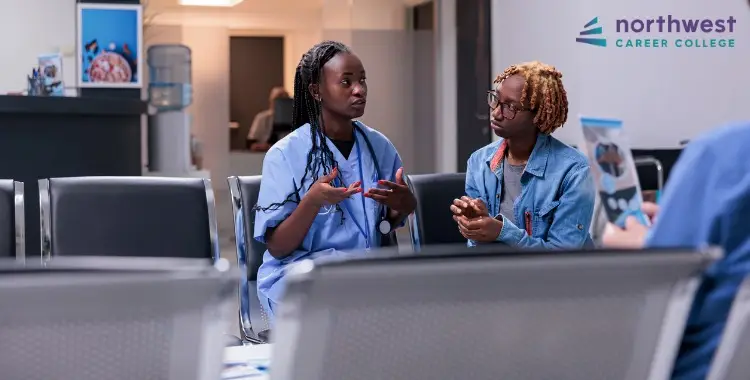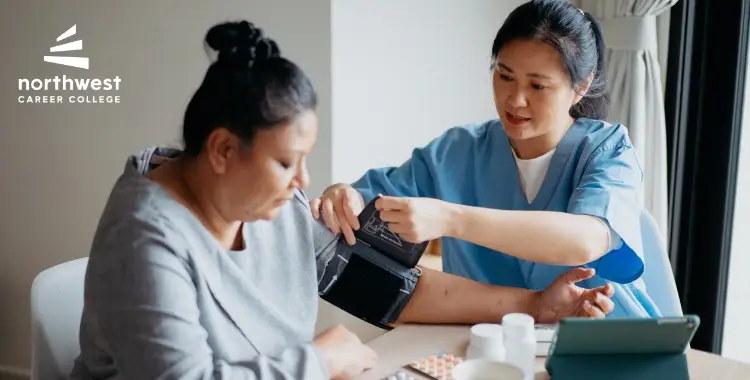Five Common Misconceptions about Medical Assistants
- Medical Assistant
- March 25, 2025
- 3.0k views
- 5 min read

Are you or someone you know thinking about going back to school to become a medical assistant, but you are not sure what exactly they do? Or you may have read some stuff online about medical assistants’ scope of practice, but you aren’t sure what to believe.
This article will dispel five common myths about medical assistants and hopefully help you feel more confident when deciding if a career as a medical assistant is right for you.
Table of Contents
- Myth #1 – Medical Assistants Lack Comprehensive Training
- Myth #2 – Medical Assistants Handle Primarily Administrative Tasks
- Myth #3 – Medical Assistants Only Work in Physician’s Offices
- Myth #4 – Medical Assisting is Just a “Stepping Stone” to an Advanced Medical Career
- Myth #5 – Medical Assistants are Just Like Nurses
- Conclusion
Myth #1 – Medical Assistants Lack Comprehensive Training
Contrary to this assumption, you should know that medical assistants typically complete a comprehensive training program that is approximately nine to ten months in length. All major certification agencies promote the education pathway as the primary pathway for obtaining a national credential as a medical assistant. While it is true that many current medical assistants were trained on the job, these individuals typically entered the field many years ago before certification was as prominent as it is today.
There are also pathways where people can become medical assistants through an apprenticeship program, where they are trained for shorter periods of time before entering the workforce. However, it is impossible to cover all the same material in just one-third of the time. Training in such programs tends to be more employer-specific, meaning your skillset may be less transferable to other offices if you pursue a new position.
Most employers prefer to work with traditional training programs that offer more comprehensive hands-on training, followed by an externship course in the field.
Myth #2 – Medical Assistants Handle Primarily Administrative Tasks
It is true that many medical assistants have an administrative component to their job responsibilities, which may include but are not limited to scheduling patients, confirming appointments, maintaining electronic records, arranging for referrals, and arranging for prescriptions. However, their responsibilities typically extend far beyond administrative tasks.
Medical assistants are a key player in delivering high-quality patient care in most outpatient settings nationwide. Medical assistants represent a significant percentage of clinical healthcare workers in the United States. Their clinical responsibilities include patient intake or triage (such as collecting vital signs, chief complaints, and medical histories), preparing patients for examinations, assisting with minor surgeries, conducting blood draws, and many other procedures, depending on the medical specialty of their practice.
Medical assistants operate semi-autonomously within medical practices, and by doing so, they significantly expedite medical care and improve the efficiency of licensed healthcare providers, such as nurses, physician’s assistants, or physicians.
Myth #3 – Medical Assistants Only Work in Physician’s Offices
While medical assistants are indeed most commonly in physician’s offices, they are also employed in a wide variety of alternative healthcare settings. Depending on your region of the country, they may be employed in hospitals, urgent care centers, or nursing homes. They also may be employed in larger medical clinics that offer primary care (e.g. union medical clinics).
The vast majority of healthcare facilities benefit daily from the skills and contributions of medical assistants because they are so versatile within their scope of practice.
Myth #4 – Medical Assisting is Just a “Stepping Stone” to an Advanced Medical Career
Although medical assisting can be the first step on a journey towards a highly credentialed healthcare position, it is essential to recognize that it is a legitimate and fulfilling career path in its own right. Many medical assistants have worked in the field for decades, as it can be incredibly rewarding to build relationships with patients in a way that is often impossible in other licensed healthcare professions.
On the other hand, some medical assistants gain experience in the field for several years before pursuing advanced education. A background in healthcare may make it easier for students to gain admission into highly competitive vocational programs, such as nursing or radiography. Students pursuing the highest levels of education and credentialing (e.g. physician’s assistants, nurse practitioners, and physicians), will not typically benefit from medical assistant experience, as admissions criteria for such programs rely heavily on bachelor’s level or higher education.
Myth #5 – Medical Assistants are Just Like Nurses
As referenced above, many medical assistants ultimately pursue a career in nursing. However, these two professions significantly differ in their scope of practice and focus. Nurses typically work in a hospital, urgent care, or skilled nursing facility, whereas medical assistants may work in a broader range of settings.
Nurses typically possess advanced degrees and are always required to maintain an active license with their state board of nursing. Nurses are also more involved in the coordination of care and the administration of pharmaceuticals compared to medical assistants. They may also perform more high-pressure, intricate medical procedures independently than medical assistants, but it varies based on their specialty setting.
Medical assistants are not typically required to maintain an active license but are often expected to maintain national certification. Medical assistants have more administrative responsibilities to patients, scheduling, and processing of referrals, but similar levels of administrative expectations related to maintaining electronic health records.
Conclusion
In conclusion, Medical assisting is a beautiful, fulfilling profession, and one that offers great opportunities for many individuals seeking to begin their career in healthcare.
Medical assistants are key contributors to the overall healthcare industry in the United States. They manage various tasks that help ensure optimal patient care in a broad range of healthcare settings.
It is essential that we debunk the myths described above, as demand for medical assistants and the skills they provide has increased significantly over the past 15 years and is projected to continue growing rapidly over the next 15 years.





